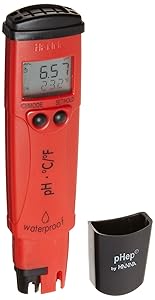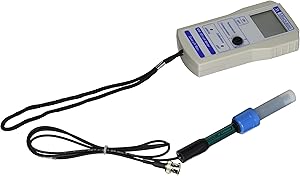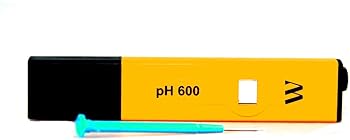Testing the pH in freshwater aquariums and marine tanks is an essential part of caring for our aquatic pets. pH Meters is an environmental parameter that must be periodically checked whether you have a tiny tank or a 200-gallon reef aquarium stocked with exotic corals and fish.
Testing pH is simply part of providing proper aquarium care and ensuring your fish, plants, and invertebrates remain healthy.

We’ll look at why pH is important and the various ways to test it, with an emphasis on pH meters.
[toc]
What does the pH symbol mean?
The term “pH” was invented in 1909 by a Danish biochemist named Søren Peter Lauritz Sørensen.
The letters pH stands for “power of hydrogen.”
The small “p” is short for the German word for power (potenz).
The letter “H” is the symbol for the element hydrogen. The H is capitalized because that’s the correct way to write the elemental symbol.
What is pH?
pH is the measure of the relative amount of hydrogen (H+) and hydroxyl (OH-) ions in a solution. In our case, the solution is tap water or aquarium water.
The pH measurement scale ranges from 0 to 14. A pH of 7 is considered “neutral.”
As the level of acidic hydrogen ions increases, the water becomes more acidic. The more acidic, the lower the pH number.
As the hydroxyl ions increase, the pH increases. When the pH climbs above 7, it becomes more basic.
Understanding pH measurements
The pH measurement scale is logarithmic. Each number represents a 10-fold change in the acidity of the water. Here’s an example. Water with a pH of 6.0 is ten times more acidic than pH 7.0 water.
pH is not necessarily an indicator of the strength of the acid.
Amazon river water with a pH of 5.0 is 100-times more acidic than water with a neutral pH of 7.0.
Lemon juice has a pH of about 2.0. Hydrochloric acid (HCl) also has a pH of about 2. It will destroy your clothes and burn your skin. Lemon juice and hydrochloric acid have the same pH.
Lemon juice is a weak acid. Hydrochloric acid is a strong acid. One is safe to drink, and the other could kill you.
How pH affects aquatic life
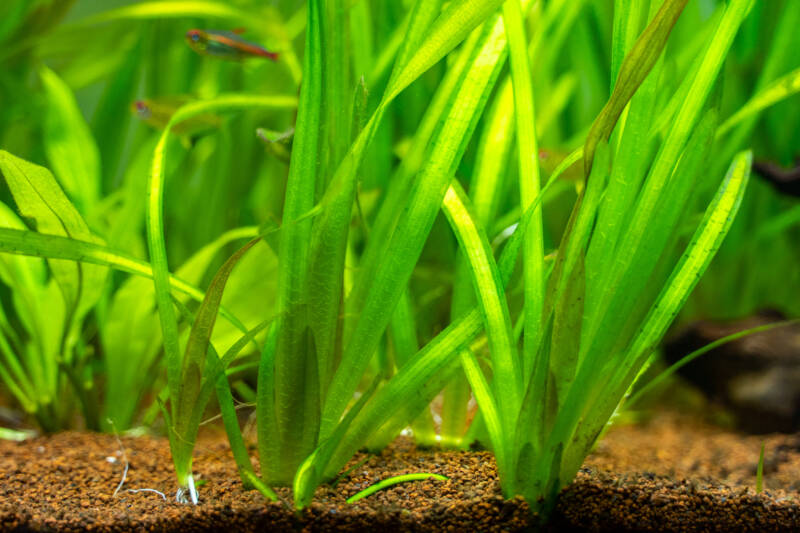
All aquatic life is in some way affected by the pH level in their environment.
Freshwater aquatic plants release acidic substances at their roots to dissolve essential minerals like iron.
The pH of the water determines which nutrients are chemically available for absorption by the roots, stems, and leaves.
Your fish’s gills are used to take in oxygen (O2) and release carbon dioxide (CO2).
Ammonia, a byproduct of protein metabolism, is excreted through the gills and appears to be somewhat pH-regulated.
Electrolyte levels in the blood and tissues are a delicate balance between the gills and external water. Therefore, extremes in pH in nature or the aquarium can disrupt the ability of fish and invertebrates to maintain a healthy metabolism.
One recent study revealed that when zebra danios were kept in aquariums outside of safe pH ranges, they suffered from reduced red blood counts and a lack of oxygen-carrying capacity. In addition, high levels of stress hormones were also released into the fish’s body when the pH drifted out of their safe zone.
Reef-building corals actually maintain a pH microenvironment of 8.4 to 8.6 around their polyps to maximize the formation of the coral skeleton and fight against pH drift.
pH recommendations for the aquarium
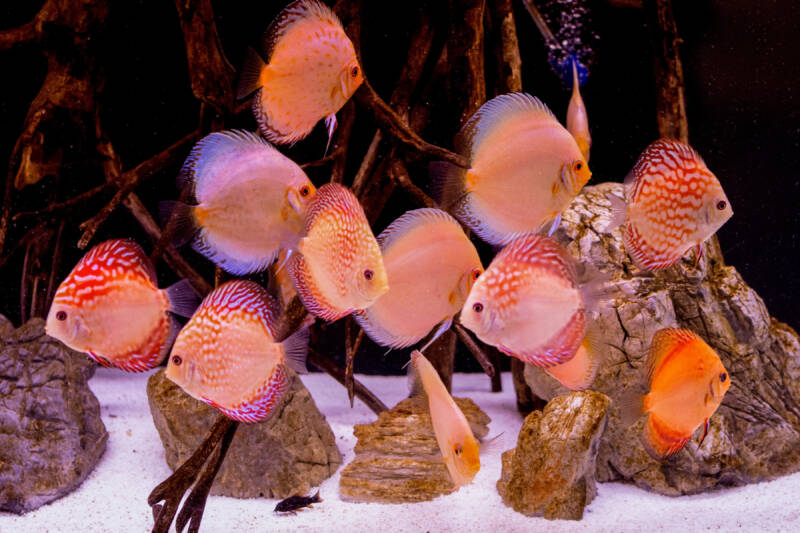
Freshwater fish and invertebrates like crayfish, shrimp, clams, and snails originate from a diverse range of natural environments.
Most tropical fish thrive in a pH range of 6.5 to 8.0.
African lake cichlids live in water with high mineral content and pH range of 8-9. At the other extreme, Amazonian rivers containing cardinal tetras and discus can have a pH as low as 4.5.
The truth is, in natural aquatic habitats, the pH fluctuates up and down during every 24-hour cycle. It can even briefly drift into extreme levels as it rises and falls throughout the day.
The gradual pH swing does not harm the fish. It’s the extended periods of unsafe pH that have stressful effects on aquatic life.
Saltwater reef fish, invertebrates like small polyp stony (SPS), large polyp stony (LPS) corals and other marine life live in a fairly narrow pH range of 7.7 to 8.4, requiring diligent pH monitoring.
Some fish enthusiasts keep specialty aquariums at the edge of conventual pH ranges for breeding or to recreate extreme aquatic niche tanks.
But most freshwater aquarists should aim for a pH range of 6.5 to 8.0. Saltwater fish tanks and reef aquariums should be kept at 8.1 to 8.4
Factors affecting pH in freshwater aquariums
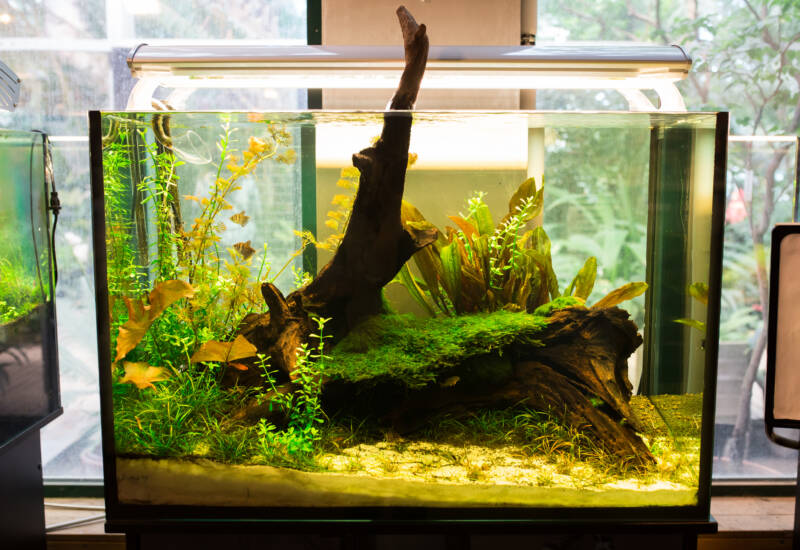
The water used to fill up the freshwater aquarium has a major effect on the pH.
The chemical make-up and pH of municipal and well water supplies vary greatly from region to region and even within the same city.
The level of calcium and magnesium (water hardness) can range from almost zero to very high. But water hardness has no effect on pH.
Alkalinity, the combination of bicarbonate and carbonate, is what regulates pH in these water sources.
Alkalinity tends to raise the pH above 7.0 and hold it steady somewhere in the 7.0 to 8.0 range. But once in the aquarium, biological and chemical processes produce acidic substances that can lower pH.
If your water supply is naturally low in alkalinity, the pH is going to run in the acidic pH range. Some water supplies have a very high pH, above 8.5.
Factors affecting pH in saltwater aquariums

Synthetic sea salt mixes are formulated to replicate natural seawater when dissolved in freshwater. Synthetic seawater contains a buffer system that adjusts and stabilizes the pH.
Ideally, the pH will range somewhere between 8.2 and 8.4.
Salt manufacturers base the formula of their marine salt products on using purified water. That way, the final salt solution is not influenced by minerals and pH of unfiltered tap water.
While many marine aquarists use tap water to make salt for their fish tanks, reef hobbyists are switching to reverse osmosis (RO) water.
A reverse osmosis system removes nearly all of the minerals, salts, and algae-promoting nutrients like phosphate from the tap water.
Reef aquarists want the best quality water for mixing their salt and topping off for evaporation. Reverse osmosis eliminates the worry about nitrate, heavy metals, and the influence of tap water on the final pH of the saltwater.
Testing pH with dip strips
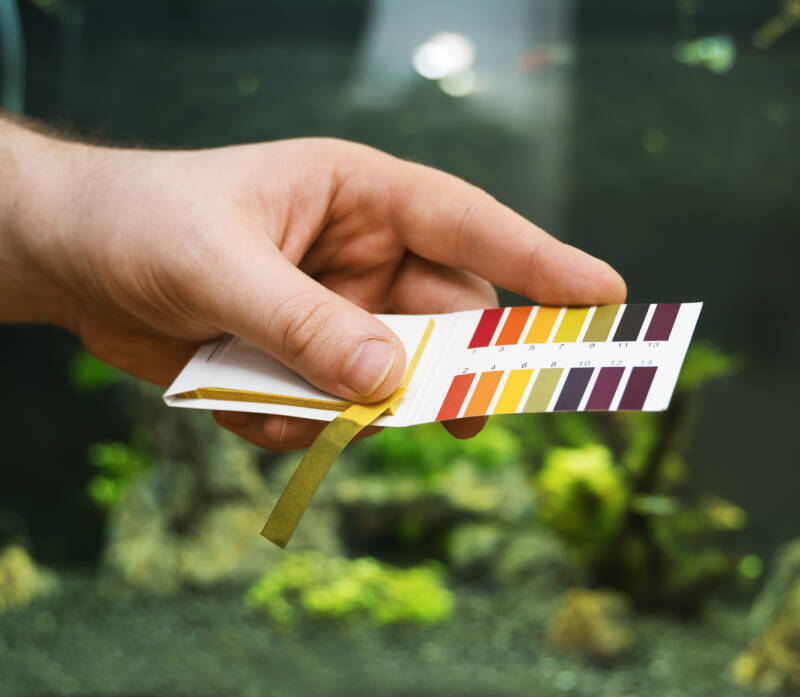
There are three ways to test the pH of your aquarium.
The simplest method is with dip strips. The plastic test strips have a pad containing a pH-sensitive dye on one end. This end is dipped into the aquarium water for a few seconds and removed.
The pH-sensitive dye reacts to the pH of the aquarium water. It will change color based on pH. You match the strip color to a chart that indicates pH based on the color of the strip.
This type of pH test method is fast and easy but not the most accurate.
That’s because the range of distinctive color shades is limited when viewing them on the end of a test strip. Plus, there’s the limitation of our eyes to detect subtle changes in color.
The best you can do with a pH test strip is wide increments like pH 7.8, 8.2, 8.4. and 8.8. Often the colors appear the same and are difficult to distinguish.
Testing pH with liquid test kits
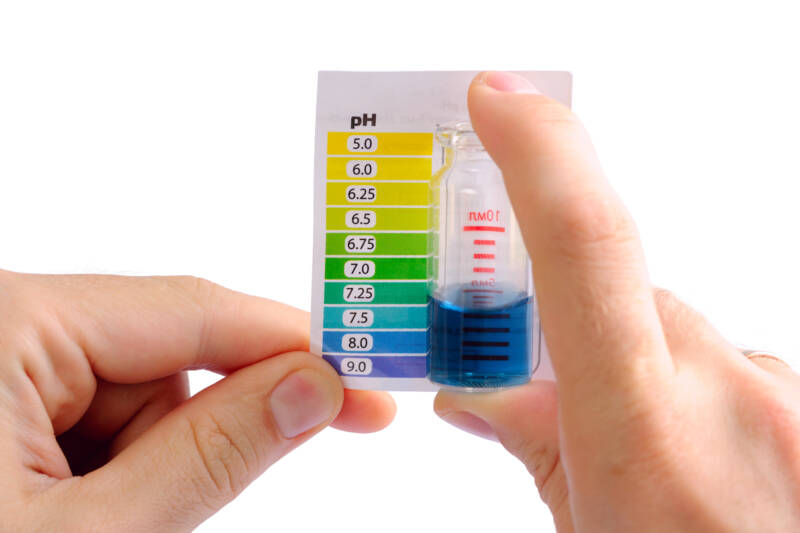
Liquid-based pH test kits use a test tube to collect a water sample.
Drops of pH-sensitive dye are added to the test tube. The test tube is capped and shaken to disperse the dye. The water in the test tube will take on the color of the dye. pH is determined by matching the color in the test tube to a pH chart. The translucent solution in the test tube allows for better color matching.
Liquid pH test kits have smaller pH increments on the color chart, but there are limitations to what color shades our eyes can see looking through a test tube.
Limitations of liquid pH test kits
If you have a freshwater aquarium with very low alkalinity, you’ll want to keep a close watch on the pH level. While your goal is an acidic aquarium, you don’t want the pH to drop too low.
The trouble is in low alkalinity water; the pH test chemicals will change the pH of the water in the test tube. That’s because there is such a low level of alkalinity. The end result is you get a pH reading of the test solution, not the aquarium water.
You’ll also find that you won’t be able to tell the difference between small pH increments. Our eyes can’t tell the color difference between pH 8.2 and 8.3. The colors are too subtle.
Lastly, some aquarists just have a hard time judging colors, even under ideal natural daylight. The solution to these problems is a pH meter.
What is a pH meter?
Unlike test kits that rely on your ability to accurately see color and match it to a chart, a pH meter displays the pH level on an LCD screen.
There’s no guessing at a color match.
A typical pH meter used by an aquarist consists of a special measuring probe connected to an electronic meter.
The probe is usually made of glass and must be handled with care. It contains two electrodes, a sensing electrode and a reference electrode. Each electrode sits in its own glass tube within the probe.
One tube contains a pH 7 buffer, and the other contains a potassium chloride solution. When the pH probe is placed in water, it measures the tiny voltage between the two electrodes.
The pH meter also has a temperature-sensing probe which is required for automatic temperature compensation (ATC). The meter takes the voltage and temperature and converts it into a pH reading.
Why use a pH meter?
pH meters take the human factor out of pH measurement.
For the basic aquarist, a pH test kit is close enough to know if your pH is drifting out of the safe zone. But for the more serious fish-keeper, breeder, reef enthusiast, or just a techie a pH meter makes perfect sense.
You’ll be able to obtain pH measurements up to two decimal places, like pH 6.8 or 8.48.
A pH meter allows you to accurately record and plot out precise pH trends in your freshwater or marine aquarium.
If you have multiple aquariums, you’ll be able to quickly take pH measurements in each tank.
While you’re at it, you can also keep a check on the pH of your tap water. Water treatment facilities sometimes switch water sources or treatment methods. This can change the pH of the water coming out of your faucet.
Tips for using a pH meter
- pH meters must be calibrated using pH buffers. Depending on your meter, it may require one or two buffer solutions to calibrate the meter.
- pH meters are designed to be calibrated with specific pH buffers. Make sure you use the same buffers as specified by the manufacturer.
- Calibrate the meter in the same range as your aquarium. If you have a reef aquarium, calibrate the meter using the high range buffer recommended by the manufacturer. Two-buffer calibration should bracket the pH of your tank. For example, an acidic Discus aquarium would use a pH 4 buffer and a pH 7.0 buffer to be most accurate in this range.
- The probe should be rinsed in distilled or reverse osmosis water after each use.
- The probe should not dry out. The instruction manual will explain how to keep it wet in storage.
- pH probes typically last several years with proper care.
Recommended pH meters for aquariums
The pH 60 pH meter has many features that professional fish and coral breeders look for.
The meter is waterproof, ensuring if it gets splashed or dropped into an aquarium, it won’t short-circuit. It can be calibrated with up to three pH points for super accuracy.
The meter recognizes five types of pH calibration solutions (1.68, 4.00, 7.00, 10.01, 12.46).
It uses a high-quality glass probe that’s replaceable in case you break it. The automatic shut-off feature saves battery life. Other features include:
- Backlit LCD screen
- 2 decimal place display
- Automatic push-button calibration
- Includes a rugged storage case
- Comes with pH buffers
- Uses AAA batteries
If you want to automatically control the meter via Bluetooth and log pH readings over time, the Apera PH60-Z Smart meter has these functions. Just use the phone app to monitor all your pH readings and trends over time.
The actual pH probe connects to the meter with a 10-foot BNC-style cable.
The Pinpoint uses a two-buffer calibration system. The kit comes with pH Meters 7 and 10 buffers.
- Powered by a standard 9-volt battery (not included)
- 2-year warranty
- Replacement probes are available
- Comes with the probe storage solution
- Includes a special probe storage vial
Hanna Instruments manufactures a variety of water testing instruments for aquariums.
This pH probe is replaceable. This pH meter does not have a temperature probe or automatic temperature compensation. The resolution is one decimal place (0.1).
- Uses a CR2032 Li-ion battery rated for 1,000 hours
- Automatic push-button calibration
- Comes with pH 4 and pH 7 buffers for calibration
- Includes a carrying case for storage
The more advanced Hanna pHep5 pH / Temperature tester offers complete waterproof protection.
The small meter will fit in your pocket. Unlike the Checker, this pH meter has a temperature probe for automatic temperature compensation.
The hold feature allows you to lock in the pH display once the reading is stable. The pHep5 has a resolution of two decimal places. Calibration solutions are not included.
- Automatic shut off when the battery is too low
- Works with 4.01 / 7.01 / 10.01 or pH 4.01 / 6.86 / 9.18 buffer ranges
- pH probe is replicable
- Suitable for marine and freshwater aquariums
- Uses 2 AA batteries (included)
Milwaukee manufactures a wide range of pH meters for aquarists, laboratories, and industry.
The meter unit is a sturdy plastic case with a large LCD display.
There is no temperature probe and no automatic temperature compensation. You must manually adjust a dial to the temperature of your aquarium water.
The meter comes with a pH probe storage container to keep the probe wet in storage.
- Calibrates to 4.01 and 7.01 or 10.01
- 2-decimal resolution
- Comes with a screwdriver to calibrate the meter
- Includes 7.01 & 4.01 calibration solutions
This small “pen” pH meter does not have a temperature probe and can’t compensate for temperature changes.
It is a single-point pH meter with a single decimal resolution.
It has a tiny LCD screen that displays the pH level. A budget pH meters for estimating pH in freshwater.
- Fits in your pocket
- Comes with a calibration screwdriver
- One decimal resolution
This small pen-type pH meter has automatic temperature compensation. The back-lit LCD displays the temperature and pH level. The uses a single-point calibration.
It auto senses the pH calibration solutions of pH 4.0, 7.0 or 10.0. Just press the calibration button, and the meter senses which buffer you’re using. This pH meter is suitable for marine and freshwater testing.
The meter has a one-decimal resolution.
- Comes with a pH 7.0 calibration packet
- One-button calibration (single point)
- Automatic shut-off
- Hold the button for locking in the result
The PH-200 meter looks similar to the Apera pH 60 water-proof pH meter, but there are many differences.
PH-200 uses a single-point calibration. The manufacturer does not indicate if the meter uses automatic temperature compensation.
The meter is waterproof and comes with AAA batteries.
- Water-proof
- Comes with a pH 7.0 calibration packet
- Suitable for freshwater aquariums
Recommendations
If you’ve decided that a pH meter is right for you, you’ll want an accurate, reliable meter. When it comes to pH meters, low cost always sacrifices something, like pH range, accuracy.
That’s why I recommend the Apera pH meters. Both models are top of the line with features and accuracy and features.
I recommend these if you’re a reef aquarist or serious aquarist with a specialty in fish and plants.
My next choice is the Milwaukee MW101 pH meter. While it is a basic two-point pH meter, it is durable and reliable. Once you know the water temperature of your tank, just adjust the dial on the meter. This is a great meter for freshwater or marine aquariums.
If you have any questions or comments, please post them below.




